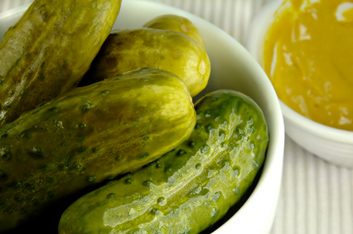
1. Curb your gourmet tendencies
You wouldn’t dream of ordering a club sandwich with fries, but a Tuscan chicken wrap with red-pepper aioli? Yes, please! Posh-sounding adjectives can sway you into choosing more indulgent foods, and then eating more of them, says Dr. Brian Wansink, PhD, director of the Food and Brand Lab at Cornell University and author of Mindless Eating: Why We Eat More Than We Think. When it comes to eating, remember that expensive-sounding meals are often rich in calories!

2. Finish with fruit
For dessert, fresh fruit and berries-without the ice cream-are your best choice. If you are hankering for something sweet, sprinkle on some sweetener from one of the packages designed for coffee/tea. Most other desserts are a dietary disaster. Gallop suggests avoiding dessert. If a birthday cake is being passed around, share your piece with someone. A couple of forkfuls with your decaf coffee should get you off the hook with minimal dietary damage!

3. Remember the 90 percent rule
A diet is not a straitjacket. Most people are successful if they stay within the rules 90 percent of the time according to diet guru Rick Gallop in his book, The G.I. Diabetes Clinic That additional 10 percent can be used for special treats: that unavoidable drink, or lunch out with the friends who love all the “wrong” foods.

4. Hire a dietitian
Over two sessions ($50 to $75 each; covered by some benefit plans), your dietitian will create a meal plan to your liking. A study in the Journal of Women’s Health showed that women who were given structured weight-loss plans in the early days after giving birth lost an average of 16 pounds in one year, compared to those who were given only general advice, who lost just three pounds. Total cost: $100 to $150.

5. Keep the evidence
Whether you’re whisking away plates between courses or tossing candy wrappers away as you nibble, the effect is the same: you eat more. Wansink’s research found that people ate less when surrounded by the spoils.

5. Keep the evidence
Whether you’re whisking away plates between courses or tossing candy wrappers away as you nibble, the effect is the same: you eat more. Wansink’s research found that people ate less when surrounded by the spoils.

6. Stability ball workouts
Stability balls improve your workout because the unstable surface of the ball forces the body to engage more muscles to maintain balance. The core body muscles (abs and back) are targeted along with the muscles you are exercising. For example, instead of standing while doing upper body exercises, sit on the ball and perform the movements. Stability balls are great for home use and there is a wide variety of DVDs available to help you with your workout.

7. Turn off the tube
We all want to know what happens next on CSI. But a study from U.S. Centers for Disease Control and Prevention concluded that people who spent four hours or more daily on screen time (TV or computer) were more likely to regain excess weight. So, get off the couch and get moving!

8. Rethink what’s delicious
“When we see food we like, we are exceedingly compelled to eat it,” says Dr. Alain Dagher, a neurologist at the Montreal Neurological Institute and Hospital. “Unfortunately, our brains are likely wired to value high-calorie foods, which is important if food is scarce or difficult to obtain,” he explains.??One way to counter this is to increase the appeal of low-calorie foods by thinking about them more positively.

9. Take a nap
In Japan, many people take a daily 20- to 30-minute nap, says James Maas, a sleep researcher at Cornell University and the author of Power Sleep. There is increasing evidence that chronic sleep deprivation raises the risk of weight gain. Maas cites two hormones: leptin, which helps the brain sense when you’re full, and ghrelin, which triggers hunger. The less sleep you get, the lower your leptin levels-and the higher your ghrelin. “Many people think they’re hungry when they’re actually sleepy,” Maas says. “Instead of a snack, they need shut-eye.”

10. Eat more pickles
In Hungary, people eat pickles to lose weight. Hungarians like things pickled-not just cucumbers but bell peppers, cabbage and tomatoes. All of these brined beauties can help keep you thin, probably because of ?the vinegar that pickles them. Growing evidence suggests that acetic acid, the main component of vinegar, helps reduce blood pressure, blood sugar levels and fat formation. If you’re watching your sodium intake, though, check the product label-pickled foods can be high in salt.
Related:
• 6 ways to maintain weight loss
• 7 things that are secretly making you gain weight
• 11 food swaps to help you lose weight
